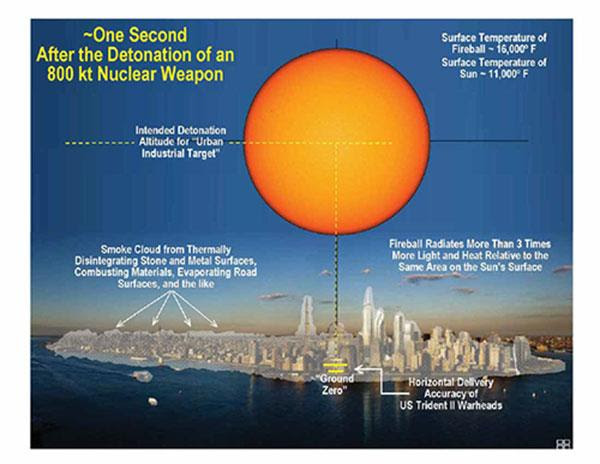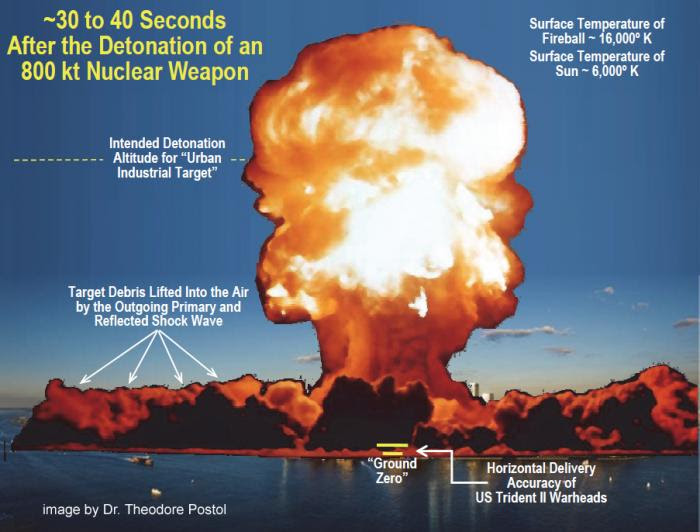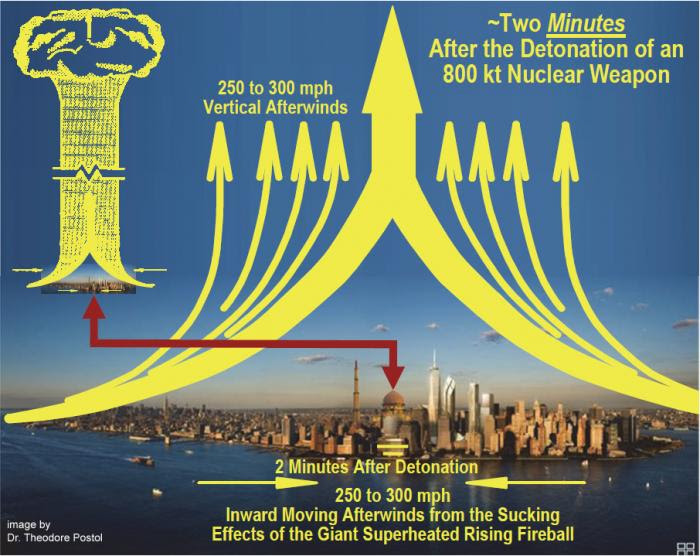
On a clear day with average weather conditions, the enormous heat and light from the fireball would almost instantly ignite fires over a total area of about 100 square miles.

The mass fire, or firestorm, would quickly increase in intensity, heating enormous volumes of air that would rise at speeds approaching 300 miles per hour. This chimney effect would pull cool air from outside the fire zone towards the center of the fire at speeds of hundreds of miles per hour. These superheated ground winds of more than hurricane force would further intensify the fire. At the edge of the fire zone, the winds would be powerful enough to uproot trees three feet in diameter and suck people from outside the fire into it.
The inrushing winds would drive the flames from burning buildings horizontally along the ground, filling city streets with flames and firebrands, breaking in doors and windows, and causing the fire to jump, sometimes hundreds of feet, swallowing anything not already violently combusting.
These above-hurricane-force ground winds would have average air temperatures well above the boiling point of water. The targeted area would be transformed into a huge hurricane of fire, producing a lethal environment throughout the entire fire zone.

Slightly more than a mile from ground zero are the neighborhoods of Chelsea, Midtown East, and Lenox Hill, as well as the United Nations; at this distance, for a split second the fireball would shine 10,000 times brighter than a desert sun at noon. All combustible materials illuminated by the fireball would spew fire and black smoke.
Grass, vegetation, and leaves on trees would explode into flames; the surface of the ground would explode into superheated dust. Any flammable material inside buildings (paper, curtains, upholstery) that was directly exposed to the fireball would burst into flame. The surfaces of the bronze statues in front of the UN would melt; marble surfaces exposed to the fireball would crack, pop, and possibly evaporate.
At this distance from the fireball, it would take about four seconds for the blast wave to arrive. As it passed over, the blast wave would engulf all structures and crush them; it would generate ferocious winds of 400 to 500 miles per hour that would persist for a few seconds. The high winds would tear structural elements from buildings and cause them to disintegrate explosively into smaller pieces. Some of these pieces would become destructive projectiles, causing further damage. The superheated, dust-laden winds would be strong enough to overturn trucks and buses.
Three miles from ground zero, in Union City, New Jersey, and Astoria, Queens, the fireball would be as bright as 1,900 suns and deliver more than five times the thermal energy deposited at the perimeter of the mass fire at Hiroshima. In Greenpoint, Brooklyn, and in the Civic Center of Lower Manhattan, clothes worn by people in the direct line of sight of the fireball would burst into flames or melt, and uncovered skin would be charred, causing third-degree and fourth-degree burns.
It would take 12 to 14 seconds for the blast wave to travel three miles after the fireball’s initial flash of light. At this distance, the blast wave would last for about three seconds and be accompanied by winds of 200 to 300 miles per hour. Residential structures would be destroyed; high-rises would be at least heavily damaged.

Fires would rage everywhere within five miles of ground zero. At a distance of 5.35 miles from the detonation, the light flash from the fireball would deliver twice the thermal energy experienced at the edge of the mass fire at Hiroshima. In Jersey City and Cliffside Park, and in Woodside in Queens, on Governors Island and in Harlem, the light and heat to surfaces would approximate that created by 600 desert suns at noon.
Wind speed at this distance would be 70 to 100 miles per hour. Buildings of heavy construction would suffer little structural damage, but all exterior windows would be shattered, and non-supporting interior walls and doors would be severely damaged or blown down. Black smoke would effuse from wood houses as paint burned off surfaces and furnishings ignited.
Six to seven miles from ground zero, from Moonachie, New Jersey, to Crown Heights, Brooklyn, from Yankee Stadium to Corona, Queens and Crown Heights, Brooklyn, the fireball would appear 300 times brighter than the desert sun at noon. Anyone in the direct light of the fireball would suffer third degree burns to their exposed skin. The firestorm could engulf neighborhoods as far as seven miles away from ground zero, since these outlying areas would receive the same amount of heat as did the areas at the edge of the mass fire at Hiroshima.
Nine miles from ground zero, in Hackensack, Bayonne, and Englewood, New Jersey, as well as in Richmond Hill, Queens, and Flatlands, Brooklyn, the fireball would be about 100 times brighter than the sun, bright enough to cause first- and second-degree burns to those in line of sight. About 36 seconds after the fireball, the shockwave would arrive and knock out all the windows, along with many interior building walls and some doors.
After the fire burned out, the street pavement would be so hot that even tracked vehicles could not pass over it for days. Buried, unburned material from collapsed buildings throughout the fire zone could burst into flames when exposed to air—months after the firestorm had ended.
The fire would extinguish all life and destroy almost everything else. Tens of miles downwind of the area of immediate destruction, radioactive fallout would begin to arrive within a few hours of the detonation.
Editor’s note: This article is adapted from “City on Fire” by Lynn Eden, originally published in the January 2004 issue of the Bulletin of the Atomic Scientists.
ABOUT THE AUTHORS:
Lynn Eden
Eden is a member of the Bulletin’s Science and Security Board and a senior research scholar and associate director for research at Stanford University’s Center for International Security and Cooperation. Eden is also co-chair of U.S. Pugwash and a member of the International Pugwash Council. Her scholarly work focuses on the military and society, and nuclear weapons history and policy, including nuclear abolition. Eden’s Whole World on Fire: Organizations, Knowledge, and Nuclear Weapons Devastation won the American Sociological Association’s 2004 Robert K. Merton award for best book in science and technology studies.
Theodore A. Postol
A physicist, Postol is professor of science, technology, and national security policy at MIT. His expertise is in ballistic missile defense technologies and ballistic missiles more generally. Prior to coming to MIT, he worked as an analyst at the Office of Technology Assessment and as a science and policy adviser to the chief of naval operations. In 2001, he received the Norbert Wiener Prize from Computer Professionals for Social Responsibility for uncovering numerous false claims about missile defenses.
Steven Starr
Starr is the director of the University of Missouri’s Clinical Laboratory Science Program, as well as a senior scientist at the Physicians for Social Responsibility. He has worked with the Swiss, Chilean, and Swedish governments in support of their efforts at the United Nations to eliminate thousands of high-alert, launch-ready U.S. and Russian nuclear weapons; he maintains the website Nuclear Darkness.
From War to Peace is dedicated to the elimination of all weapons of war. Through the magic of disarmament and recycling, we transform weapons of war into celebrations of peace. Join us in creating a better world.









One Response
You have brought truly brought home the horrors of a nuclear attack on your country and the after effects.
There is no going back once you go down that course of action so we need to disarm.
Yours in peace.
Richard Dennis